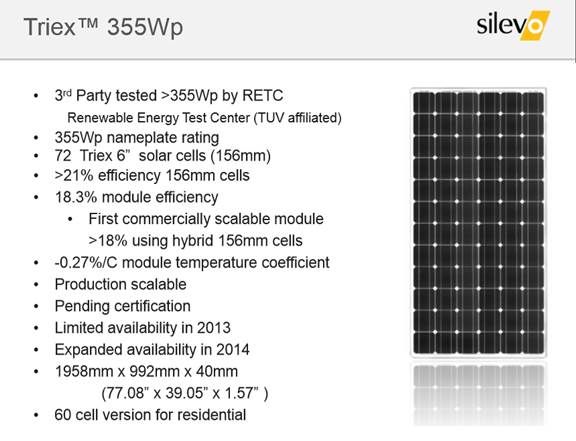Silevo advanced its high-efficiency solar technology with a new product it expects will make inroads into the marketplace.
Silevo has redesigned its cell to what Sales and Marketing VP Aaron Thurlow called the “industry-standard 156-millimeter size” and built it into a Triex 72-cell module. Thurlow said these are solar’s first high-efficiency cells to have been configured into a "standard form factor" module. The scale-up is expected to cut manufacturing costs 30 percent. Efficiencies in string architecture and inverter voltage could cut solar system costs 20 percent, according to Silevo data.
The use of the SunEdison (NYSE:SUNE) high-performance Silvantis n-type wafer was key to the new cell’s design and performance, according to a Silevo statement.
By sustaining the 18.3 percent efficiency of the previous generations of its products, Silevo’s new module was validated at 355 watts-peak output for light chamber and outdoor performance by PV third-party authority Renewable Energy Test Center (RETC), Thurlow said. This is, he said, the solar industry’s first high-efficiency, high output-standard form-factor module.
Silevo is heralding the new architectures for its hybrid part-thin-film, part-crystalline-silicon product as a significant step ahead from its 235-watts-peak, 72-cell module and its 96-cell, 305-watts-peak module. Silevo Business/Marketing VP Chris Beitel told GTM last year it could manufacture those modules at 98 cents per watt.

Thurlow would not name a price for the new module, but said its price per watt will be “highly competitive, [...] lower than the production cost of the current products, [...] significantly below the other high-efficiency players in the market” and “well below one dollar per watt.”
“And well below one dollar per watt with an 18.3 percent efficient module is different than well below one dollar per watt with a 14 percent efficient module,” Thurlow added.
Though most Tier One modules are now in the 15 percent to 16 percent efficiency range, there is some weight to Thurlow’s claim that a more efficient module in a standard size could get some play in today’s competitive market.
“This is going to push the industry toward sustainable economics without subsidies,” Thurlow added, because a developer will have the option of using fewer modules and will have lower balance-of-system costs.
SunPower (SPWR) and Panasonic (PCRFY) are the high-efficiency module makers Silevo is competing with, Thurlow acknowledged, and “because neither has a product on the market today using a 156-millimeter cell,” he said, “they have been viewed as niche players.”
“The top efficiency of our 96-cell X series panel, which is commercially available today, was recently confirmed by NREL at 21.7 percent and generates 345 watts-peak,” SunPower Module Group General Manager David DeGraaff said.
Panasonic’s best modules are close to the 20 percent mark in efficiency.

“A standard 72-cell module is 2 square meters, and a standard 60-cell module is 1.6 square meters. SunPower and Panasonic modules are essentially the same size as a conventional 60-cell module,” DeGraaff said in answer to Thurlow’s point about standard form factor. SunPower’s module is commonly used with standard racking in Europe, DeGraaff added.
Like Thurlow, DeGraaff would not offer a specific price. “We don’t quote a dollar-per-watt price,” DeGraaff said. “A PV system has to beat the per-kilowatt-hour utility charges. With a higher efficiency module, every watt produces more kilowatt-hours,” he explained. “But we are competitive. That’s why we lead in residential and why we win so many deals.”
The obvious question: what is the cost of those kilowatt-hours? The unsatisfying answer: That is proprietary information the companies do not release.



